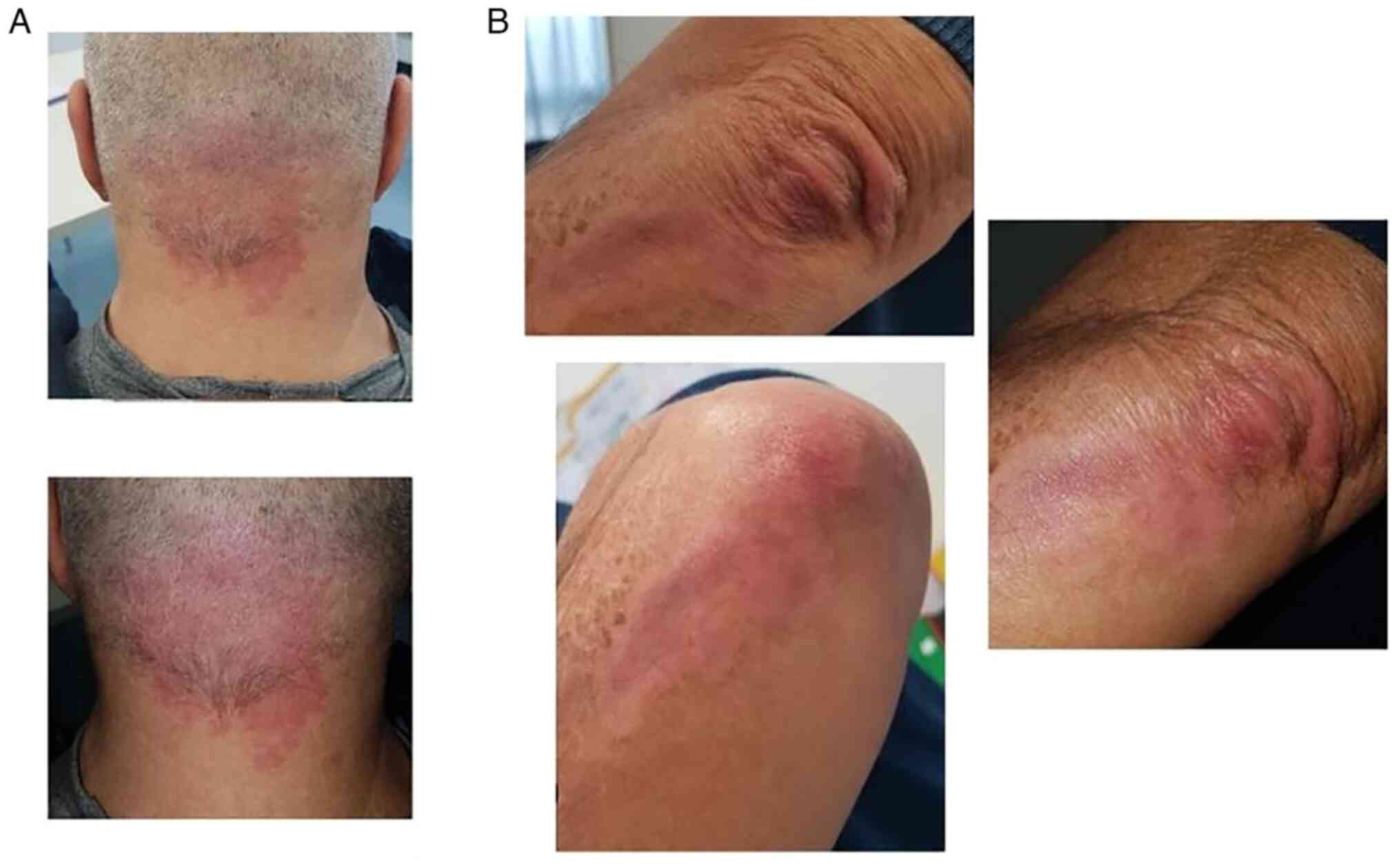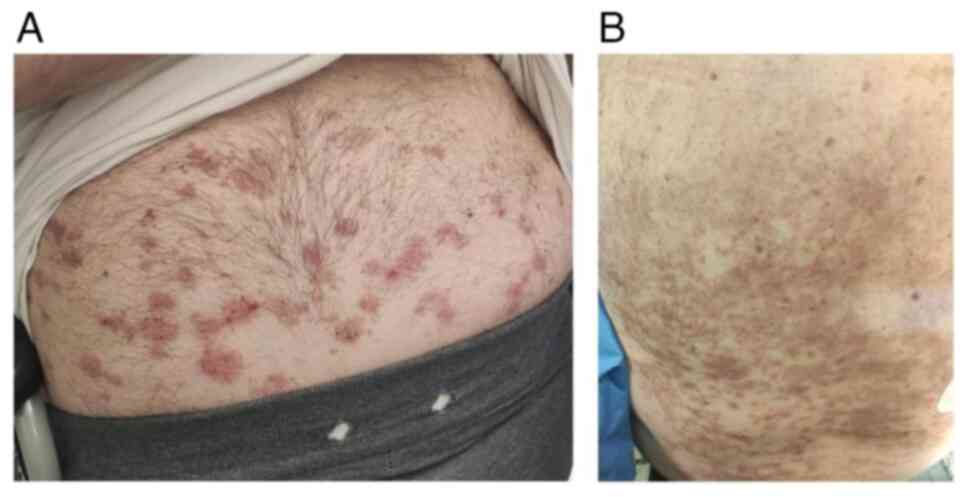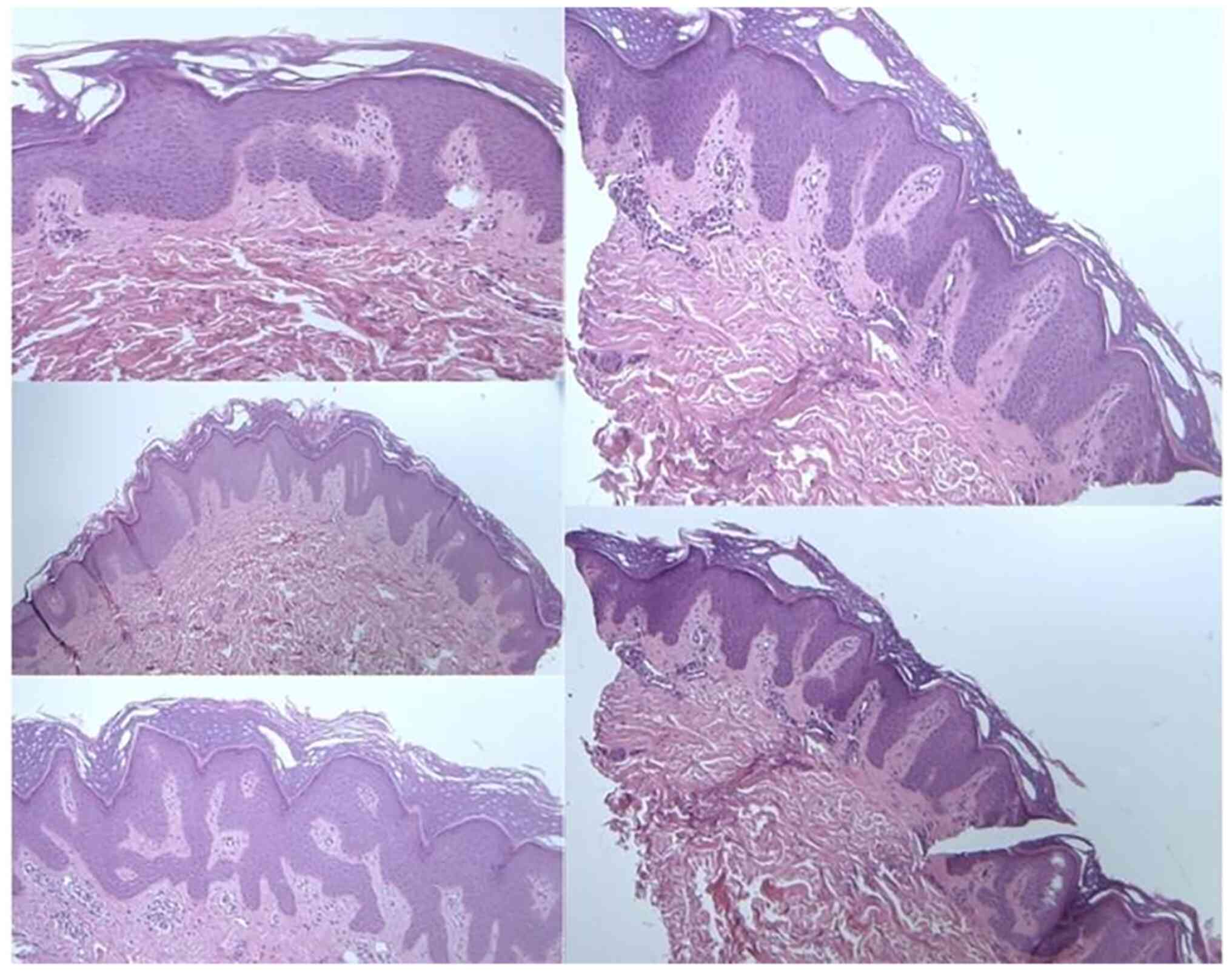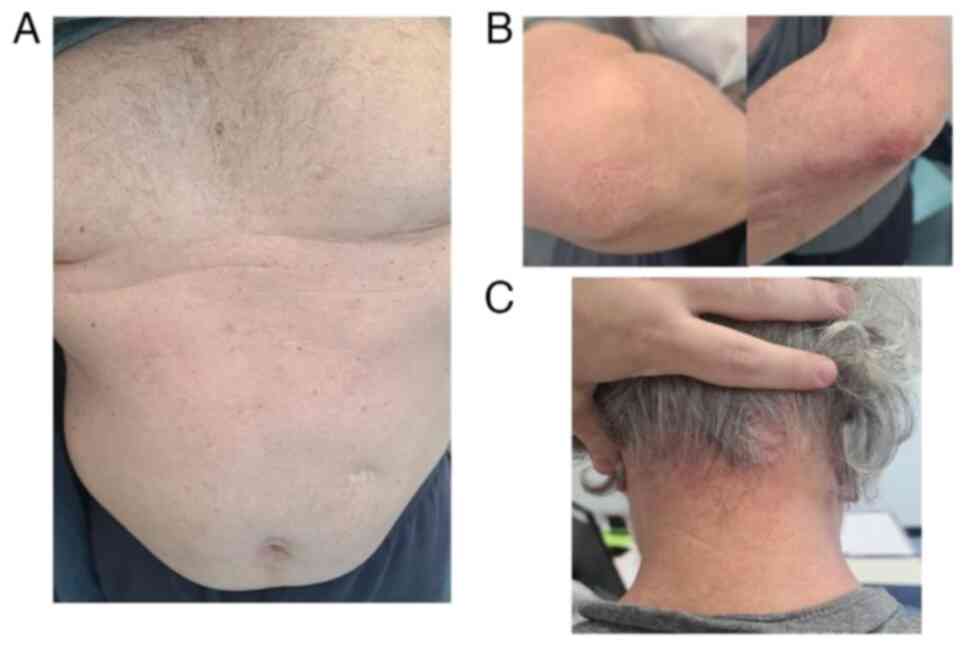Psoriasis induced by first‑line pembrolizumab in metastatic non‑small cell lung cancer: A case report
- Authors:
- Published online on: June 2, 2023 https://doi.org/10.3892/ol.2023.13897
- Article Number: 311
Abstract
Introduction
Immunotherapy has profoundly changed the history of several types of cancer such as the improvement of survival, duration of response, and quality of life compared with chemotherapy. Immune checkpoint inhibitors (ICIs) are comprehensive of different monoclonal antibodies targeting cytotoxic T lymphocyte-associated antigen 4 (CTLA-4), programmed death protein 1 (PD-1) or programmed death-ligand 1 (PD-L1) (1).
Interaction between PD-1 (on T cells) and PD-L1 (on tumor cells) induces immune system tolerance and promotes tumor growth. Consequently, the inhibition of the immune system down-regulation permits the reactivation of T-cells (2). However, the immunity activation can disrupt peripheral immune tolerance and cause immune-related adverse events (irAEs) (3).
Pembrolizumab is a humanized monoclonal antibody IgG4 PD-1 inhibitor. It blocks the interaction with PDL1 and PDL2 expressed by antigen-presenting cells (APC), tumor and other cells in the tumor microenvironment (4). It has shown efficacy in different malignancies, specifically in Non-Small cell lung cancer (NSCLC). The first-line approval came with the Keynote024 trial (5) that involved patients with metastatic NSCLC non-oncogene addicted, PD-L1 ≥50%. In this study, patients were randomized to receive pembrolizumab 200 mg q3w vs. platinum-based chemotherapy. Clinically significant results in overall survival (OS) and progression-free survival (PFS) were obtained in this population expressing high levels of PD-L1.
First-line treatment standard for patients with PD-L1 <50% is the combination of chemo and immunotherapy. In the KEYNOTE-189 trial (6), patients were randomized to receive chemotherapy + pembrolizumab + pemetrexed or chemotherapy + placebo, followed by maintenance with pembrolizumab + pemetrexed or placebo + pemetrexed. A median follow-up of 4 years confirms trial results: experimental arm OS is significantly better than the placebo arm (HR 0,60). Subgroup analysis shows that the combination is efficient even in patients with brain and liver metastasis. Positive effects are independent of PD-L1 expression.
Evidence shows that more than 60% of patients treated with immunotherapy develop irAEs. Dermatological irAEs concern between 30 and 50% of patients on ICIs and are the most frequent and the earliest (7). More than 30% reported mild skin toxicity, alone or associated with other symptoms (8). Unfortunately some severe irAEs such as Stevens-Johnson syndrome (SJS) and toxic epidermal necrolysis (TEN) and Drug Rash with Eosinophilia and Systemic Symptoms (DRESS) are life-threating are described and require the cessation of ICIs (8). The average incidence of skin irAEs reported in meta-analysis includes 16.7% for Pembrolizumab (9). For patients treated with the chemoimmunotherapy combination, the skin reactions mostly reported (frequency ≥1/10) were: alopecia, skin eruption, and pruritus. Common adverse events (≥1/100, <1/10) were severe cutaneous reactions, erythema, dermatitis, and dry skin. Uncommon adverse events (≥1/1.000, <1/100) were psoriasis, eczema, lichenoid keratosis, acneiform dermatitis, and vitiligo. Rare adverse events (≥1/10.000, <1/1.000) were nodosum erythema, papules, and change in color of skin or hair (4). Psoriatic plaques are the most frequent presentation of psoriasis but the incidence has been difficult to estimate (9). The mechanisms of pembrolizumab-induced psoriasis remains unclear. A reason could be related to the activation of Th17 lymphocytes, which typically are inactivated by PD-1 (10).
In this paper, we describe a case of psoriasis in a 68-years-old man with advanced NSCLC who developed this specific dermatology adverse event during immunotherapy.
Case report
A 68-year-old Caucasian male patient with Eastern Cooperative Oncology Group (ECOG) Performance Status 0, came to our observation, at Multispeciality Department of Oncology, ASL Latina, ‘Sapienza’ University of Rome, Aprilia, Italy in February 2020 with a histologically confirmed diagnosis of right upper lobe lung adenocarcinoma. Immunohistochemistry (IHC) showed ALK and ROS1 negative, PD-L1 <1%, and EGFR wild type in quantitative PCR.
A CT scan and brain MRI demonstrated a lung lesion of 34×25×29 mm and a single right hemispheric lesion of 7 mm asymptomatic. In April 2020 the patient started stereotactic radiation therapy, completed in 3 sessions (33,75 Gy total dose). Following, a front-line chemo-immunotherapy was set up with carboplatin AUC 5 i.v. day 1, pemetrexed 500 mg/sqm i.v. day 1 and pembrolizumab 200 mg day 1, every 21 days. Initially the patient developed diarrhea G1 as a single adverse event (AE). Then, after 2 cycles of chemo-immunotherapy, a cutaneous rash G3 (Fig. 1) appeared on the back of the chest, upper and lower limbs appeared associated with pruritus G1.
In June 2020 the patient stopped chemo-immunotherapy treatment and daily oral prednisolone 50 mg/daily for three days + ebastine 10 mg was administered. Steroids have been weaned in 10 days, with complete regression of the rash. After 3 months a CT scan showed stability of disease of the primary lesion and complete response of the hemispheric lesion post-radiotherapy.
In August 2020 the patient restarted the chemoimmunotherapy combination after seven weeks of interruption. In September 2020, after four cycles of therapy, a CT scan showed a partial response of the primary lesion. The patient started maintenance therapy with pemetrexed 500 mg/sqm and pembrolizumab 200 mg day 1, every 21 days. After 3 maintenance cycles, he manifested a re-occurrence of the rash with scaly papules on the head, abdomen, back and gluteus (Fig. 2). This was treated with prednisolone 50 mg/daily for three days, weaned over 10 days. After the interruption of prednisolone appeared an exacerbation of the cutaneous rash and pruritus G1.
In December 2020 a consultant dermatologist diagnosed psoriasiform reaction on the elbows, gluteus and scalp; a cutaneous biopsy confirmed diagnosis of psoriasis (Fig. 3). The patient denied any personal or family history of psoriasis.
Topical treatments: clobetasol foam for scalp twice daily for 15/20 days, calcipotriol + betamethasone foam once a day for 4 weeks, dexamethasone + clotrimazole on skin folds twice daily and then soothing cream.
After the complete regression of the lesions, the patient continued the maintenance treatment without pembrolizumab. The patient has completed 28 maintenance cycles with only pemetrexed with stable disease at CT revaluations. The skin manifestations of psoriasis are controlled without any local or systemic treatment (Fig. 4).
Discussion
Immunotherapy has brought the development of new strategies against NSCLC. Previously negative PD-L1 patients were considered less responsive to these new treatments, now we know that PD-L1 is not an affordable biomarker of immunotherapy sensitivity, indeed also patients with lower expression of PD-L1 could benefit from this treatment, above all combined protocols as established by KEYNOTE-189 (6). The scenery of non-oncogene addicted NSCLS is thus changed because immunotherapy constitutes the standard of care (combined with chemotherapy or not). This has certainly increased the number of patients treated with immunotherapy, as well as the experiences of both responses and adverse events.
Skin AEs are one of the most frequent AEs in patients treated with anti-PD-1 (nivolumab and pembrolizumab). Onset is quite early, within the first weeks after the infusion. Despite these serious manifestations being rare (<3%), and usually do not require the interruption of treatment (11).
Psoriasis is a chronic autoimmune disease that affects about 0,27-11,4% of the population, hits the skin, and it could impact lives of patients both physically and psychologically (12). It's often associated with multiple comorbidities such as obesity (13). This disease causes red, itchy scaly patches, most commonly on the knees, elbows, trunk and scalp (14). The histopathological features are similar to typical psoriasis vulgaris, with the presence of hyperkeratosis, hypogranulosis, acanthosis with elongated rete ridges, and a perivascular lymphocytic infiltration (7).
A health-related quality of life (HRQoL) impairment is associated with psoriasis. Itching and skin pain have been reported in 62–97 and 42–59% of patients with psoriasis, respectively (15). Furthermore, although a correlation between anxiety and psoriasis has not been demonstrated, the levels of anxiety recorded in patients with psoriasis were higher than average (16).
The mechanism of disease is a higher expression of Th1 and Th17 lymphocytes and, consequentially, cytokines such as IL-1, IL-6, and IL-17 (17). It is known that immunotherapy might exacerbate psoriatic lesions in those with positive familial or personal history of psoriasis. The most frequent presentation is plaque-type psoriasis, and it is associated with a family history (17). The mechanism under this adverse event is explained by the inhibition of PD-1/PD-L1 axis that, as reported by Dulos et al (18) and Okiyama and Tanaka (19), activates Th1, Th17 and Th22 lymphocytes with the production of IL-6 (20). In turn, IL-6 stimulates IL-17, a cytokine that downregulates T-reg cells. The balance between these types of cells is the key to autoimmune regulation and cancer (21). Another mechanism described in literature is overweight or obesity. Western Diet fed mice became obese and they have higher expression of Th-17 cytokines and PD-1 on γδ-low T cells. Imiquimod treatment elevate psoriasis inflammation and PD-1 as inhibitory regulation. Anti-PD1 treatment, as Pembrolizumab, induced a prominent PD-1 blockage effect and severe psoriasiform dermatitis (8). Our patient is overweight with a BMI of 28.7.
As in Table I, not many cases of pembrolizumab-induced psoriasis are described in the literature. We have reported patients without a personal or family history of psoriasis. The median onset time was 6 weeks, 2 cycles. Only 3 cases of NSCLC were registered.
For G1 toxicity (skin rash with or without symptoms, >10% body surface area (BSA) ESMO Guidelines recommend avoiding skin irritants, sun exposure, topical emollients, topical steroids (mild strength) cream and/or, topical or oral antihistamines for itch. For G2 (rash covers 10–30% of BSA) is recommended supportive management as above, a topical steroid (moderate strength) cream and or potent cream bd +/- topical or oral antihistamines for itch. The treatment can be continued. For G3 (rash covers >30% BSA or grade 2 with substantial symptoms) withhold ICIs, topical treatments as above (potent) and steroids. If mild to moderate 0.5/1 mg/kg prednisolone once daily for three days then wean over 1–2 weeks; or if severe, i.v. (methyl)prednisolone 0.5–1 mg/kg and convert to oral steroids on response, wean over 2–4 weeks. For G4 (skin sloughing >30% BSA with associated symptoms) i.v. (methyl)prednisolone 1–2 mg/kg with urgent dermatology review and discontinuation of ICIs (11).
Our patient, as described above, needed both topical and systemic steroids, soothing and antifungal cream to solve maculopapular rash. With the aim of preserving the recurrence and severity of psoriasis, the immunotherapy treatment was discontinued.
The majority of cases reported in Table I were treated with topical steroids. One case was treated with anti-IL-17 (secukinumab) (3), and two cases with anti-PDE4 (apremilast) (22,23). Despite the discontinuation of the treatment, the benefit of our patient, in terms of progression free survival, is consistent if compared with the median PFS of the Keynote 189 trial, which is 9.0 months (24). A meta-analysis conducted on 52 studies including 9,156 patients affected by different malignancies treated with anti-PD-1/PD-L1 agents (22), demonstrated how irAEs were statistically associated with better PFS and OS. Observing subgroups analysis, these results have been described in NSCLC, endocrine and skin toxicities but not for gastrointestinal and lung AE. The major grade of adverse events was not associated with favorable PFS or OS.
In conclusion, pembrolizumab, as an immunotherapy drug, has changed the prognosis and the quality of life of patients. Compared to chemotherapy, ICIs have a different spectrum of adverse events, mostly well tolerated. However, as in our case, they could be so severe to discontinue the treatment, even without a positive history of autoimmune disease. As mentioned above, our patient had a long response from immunotherapy despite its interruption. Although the mechanism behind irAEs remains not clear, it might be explained by a reactivation of T-cells, so that patients with a more responsive immune system are the ones who benefit more by ICIs. For these reasons, it might be important to conduct other studies to identify predictive factors of immune-related toxicities and objective response.
Acknowledgements
Not applicable.
Funding
Funding: No funding was received.
Availability of data and materials
The datasets used and/or analyzed during the current study are available from the corresponding author on reasonable request.
Authors' contributions
FG, LR, IP and AC made substantial contributions to conception and design of the manuscript. SC, AA, MB, CP and GC contributed to acquisition and interpretation of data, and wrote the abstract. DS, VP and VS performed the histological examination of the psoriasis and were major contributors in writing the manuscript, confirm the authenticity of all the raw data and gave final approval of the version to be published. All authors read and approved the final manuscript.
Ethics approval and consent to participate
Not applicable.
Patient consent for publication
The patient provided written informed consent for the publication of their data.
Competing interests
The authors declare that they have no competing interests.
Glossary
Abbreviations
Abbreviations:
|
AE |
adverse event |
|
APC |
antigen-presenting cells |
|
BSA |
body surface area |
|
CTLA-4 |
cytotoxic T lymphocyte-associated antigen 4 |
|
DRESS |
Drug Rash with Eosinophilia and Systemic Symptoms |
|
ECOG |
Eastern Cooperative Oncology Group |
|
HRQoL |
health related quality of life |
|
ICIs |
immune checkpoint inhibitors |
|
IHC |
immunohistochemistry |
|
irAEs |
immune-related adverse events |
|
NA |
not applicable |
|
NSCLC |
non-small cell lung cancer |
|
OS |
overall survival |
|
PD-1 |
programmed death protein 1 |
|
PD-L1 |
programmed death ligand 1 |
|
PFS |
progression-free survival |
|
SJS |
Stevens-Johnson syndrome |
|
TEN |
toxic epidermal necrolysis |
References
|
Nikolaou V, Sibaud V, Fattore D, Sollena P, Ortiz-Brugués A, Giacchero D, Romano MC, Riganti J, Lallas K, Peris K, et al: Immune checkpoint-mediated psoriasis: A multicenter European study of 115 patients from the European network for cutaneous adverse event to oncologic drugs (ENCADO) group. J Am Acad Dermatol. 84:1310–1320. 2021. View Article : Google Scholar : PubMed/NCBI | |
|
Monsour EP, Pothen J and Balaraman R: A novel approach to the treatment of pembrolizumab-induced psoriasis exacerbation: A case report. Cureus. 11:e58242019.PubMed/NCBI | |
|
Johnson D, Patel AB, Uemura MI, Trinh VA, Jackson N, Zobniw CM, Tetzlaff MT, Hwu P, Curry JL and Diab A: IL17A blockade successfully treated psoriasiform dermatologic toxicity from immunotherapy. Cancer Immunol Res. 7:860–865. 2019. View Article : Google Scholar : PubMed/NCBI | |
|
European Medicines Agency, . https://www.ema.europa.eu/en/documents/product-information/keytruda-epar-product-information_it.pdf | |
|
Reck M, Rodríguez-Abreu D, Robinson AG, Hui R, Csőszi T, Fülöp A, Gottfried M, Peled N, Tafreshi A, Cuffe S, et al: Pembrolizumab versus chemotherapy for PD-L1-positive non-small-cell lung cancer. N Engl J Med. 375:1823–1833. 2016. View Article : Google Scholar : PubMed/NCBI | |
|
Gandhi L, Rodríguez-Abreu D, Gadgeel S, Esteban E, Felip E, De Angelis F, Domine M, Clingan P, Hochmair MJ, Powell SF, et al: Pembrolizumab plus chemotherapy in metastatic non-small-cell lung cancer. N Engl J Med. 378:2078–2092. 2018. View Article : Google Scholar : PubMed/NCBI | |
|
Chen CH, Yu HS and Yu S: Cutaneous adverse events associated with immune checkpoint inhibitors: A review article. Curr Oncol. 29:2871–2886. 2022. View Article : Google Scholar : PubMed/NCBI | |
|
Cutroneo P, Ingrasciotta Y, Isgrò V, Rullo EV, Berretta M, Fiorica F, Trifirò G and Guarneri C: Psoriasis and psoriasiform reactions secondary to immune checkpoint inhibitors. Dermatol Ther. 34:e148302021. View Article : Google Scholar : PubMed/NCBI | |
|
Belum VR, Benhuri B, Postow MA, Hellmann MD, Lesokhin AM, Segal NH, Motzer RJ, Wu S, Busam KJ, Wolchok JD and Lacouture ME: Characterisation and management of dermatologic adverse events to agents targeting the PD-1 receptor. Eur J Cancer. 60:12–25. 2016. View Article : Google Scholar : PubMed/NCBI | |
|
Scarfì F, Lacava R, Patrizi A, Tartari F, Ravaioli GM, Veronesi G, Lambertini M and Dika E: Follicular psoriasis induced by pembrolizumab in a patient with advanced non-small-cell lung cancer. Int J Dermatol. 58:e151–e152. 2019. View Article : Google Scholar : PubMed/NCBI | |
|
Haanen JBAG, Carbonnel F, Robert C, Kerr KM, Peters S, Larkin J and Jordan K; ESMO Guidelines Committee, : Management of toxicities from immunotherapy: ESMO clinical practice guidelines for diagnosis, treatment and follow-up. Ann Oncol. 28 (Suppl 4):iv119–iv142. 2017. View Article : Google Scholar : PubMed/NCBI | |
|
Voudouri D, Nikolaou V, Laschos K, Charpidou A, Soupos N, Triantafyllopoulou I, Panoutsopoulou I, Aravantinos G, Syrigos K and Stratigos A: Anti-PD1/PDL1 induced psoriasis. Curr Probl Cancer. 41:407–412. 2017. View Article : Google Scholar : PubMed/NCBI | |
|
Yu S, Wu X, Shi Z, Huynh M, Jena PK, Sheng L, Zhou Y, Han D, Wan YY and Hwang ST: Diet-induced obesity exacerbates imiquimod-mediated psoriasiform dermatitis in anti-PD-1 antibody-treated mice: Implications for patients being treated with checkpoint inhibitors for cancer. J Dermatol Sci. 97:194–200. 2020. View Article : Google Scholar : PubMed/NCBI | |
|
https://www.mayoclinic.org/diseases-conditions/psoriasis/symptoms-causes/syc-20355840 | |
|
Honma M, Kanai Y, Murotani K, Nomura T, Ito K and Imafuku S: Itching and skin pain in real-life patients with plaque psoriasis: Baseline analysis of the ProLOGUE study. J Dermatol Sci. 105:189–191. 2022. View Article : Google Scholar : PubMed/NCBI | |
|
Yu S, Tu HP, Huang YC and Lan CCE: The incidence of anxiety may not be correlated with severity of psoriasis: A prospective pilot study. Med Hypotheses. 130:1092542019. View Article : Google Scholar : PubMed/NCBI | |
|
Huang PW and Chu CY: Pembrolizumab-induced linear psoriasis. Lung Cancer. 146:378–379. 2020. View Article : Google Scholar : PubMed/NCBI | |
|
Dulos J, Carven GJ, van Boxtel SJ, Evers S, Driessen-Engels LJ, Hobo W, Gorecka MA, de Haan AF, Mulders P, Punt CJ, et al: PD-1 blockade augments Th1 and Th17 and suppresses Th2 responses in peripheral blood from patients with prostate and advanced melanoma cancer. J Immunother. 35:169–178. 2012. View Article : Google Scholar : PubMed/NCBI | |
|
Okiyama N and Tanaka R: Varied immuno-related adverse events induced by immune-check point inhibitors-nivolumab-associated psoriasiform dermatitis related with increased serum level of interleukin-6. Nihon Rinsho Meneki Gakkai Kaishi. 40:95–101. 2017.(In Japanese). View Article : Google Scholar : PubMed/NCBI | |
|
Hara T, Mikita N, Ikeda T, Inaba Y, Kunimoto K, Kaminaka C, Kanazawa N, Yamamoto Y and Jinnin M: Psoriatic arthritis induced by anti-programmed death 1 antibody pembrolizumab. J Dermatol. 46:e466–e467. 2019. View Article : Google Scholar : PubMed/NCBI | |
|
Gadgeel S, Rodríguez-Abreu D, Speranza G, Esteban E, Felip E, Dómine M, Hui R, Hochmair MJ, Clingan P, Powell SF, et al: Updated analysis from KEYNOTE-189: Pembrolizumab or placebo plus pemetrexed and platinum for previously untreated metastatic nonsquamous non-small-cell lung cancer. J Clin Oncol. 38:1505–1517. 2020. View Article : Google Scholar : PubMed/NCBI | |
|
Suzuki M, Matsumoto S, Takeda Y and Sugiyama H: Systemic psoriasiform dermatitis appeared after the administration of pembrolizumab. Intern Med. 59:871–872. 2020. View Article : Google Scholar : PubMed/NCBI | |
|
Siciliano MA, Dastoli S, d'Apolito M, Staropoli N, Tassone P, Tagliaferri P and Barbieri V: Pembrolizumab-induced psoriasis in metastatic melanoma: Activity and safety of apremilast, a case report. Front Oncol. 10:5794452020. View Article : Google Scholar : PubMed/NCBI | |
|
Fan Y, Xie W, Huang H, Wang Y, Li G, Geng Y, Hao Y and Zhang Z: Association of immune related adverse events with efficacy of immune checkpoint inhibitors and overall survival in cancers: A systemic review and meta-analysis. Front Oncol. 11:6330322021. View Article : Google Scholar : PubMed/NCBI | |
|
Takama H, Shibata T, Ando Y, Yanagishita T, Ohshima Y, Akiyama M and Watanabe D: Pembrolizumab-induced psoriasis vulgaris successfully treated with apremilast. Eur J Dermatol. 30:188–190. 2020. View Article : Google Scholar : PubMed/NCBI | |
|
Totonchy MB, Ezaldein HH, Ko CJ and Choi JN: Inverse psoriasiform eruption during pembrolizumab therapy for metastatic melanoma. JAMA Dermatol. 152:590–592. 2016. View Article : Google Scholar : PubMed/NCBI | |
|
Bonigen J, Raynaud-Donzel C, Hureaux J, Kramkimel N, Blom A, Jeudy G, Breton AL, Hubiche T, Bedane C, Legoupil D, et al: Anti-PD1-induced psoriasis: A study of 21 patients. J Eur Acad Dermatol Venereol. 31:e254–e257. 2017. View Article : Google Scholar : PubMed/NCBI |













